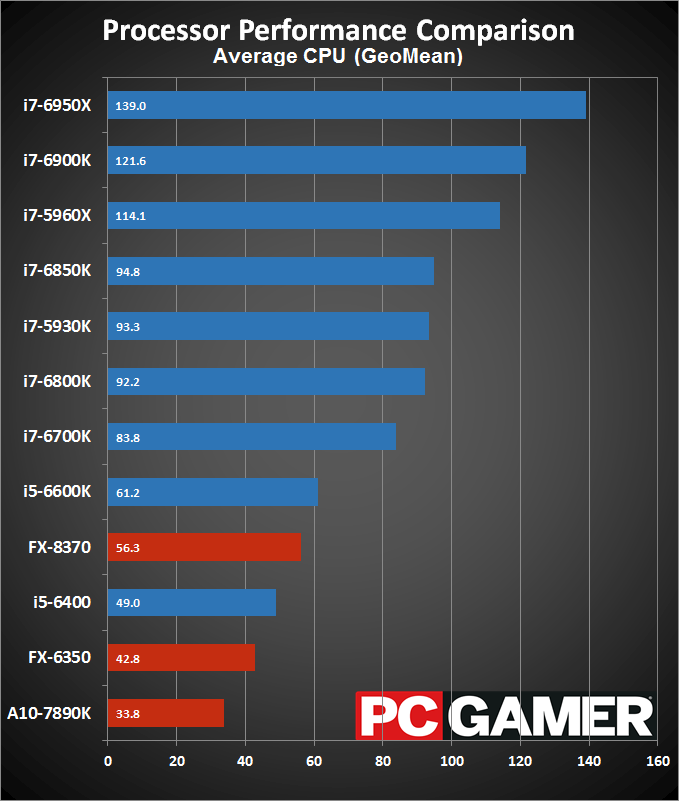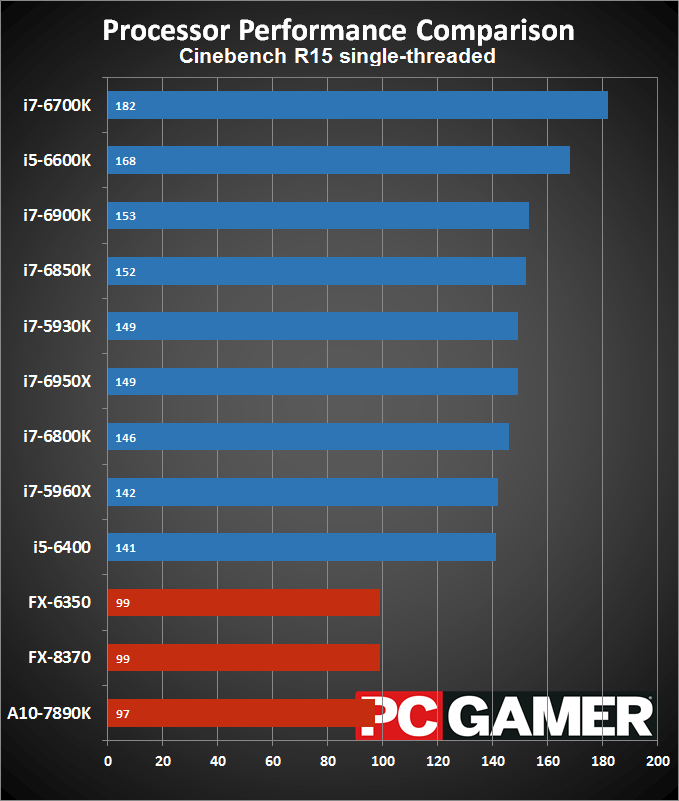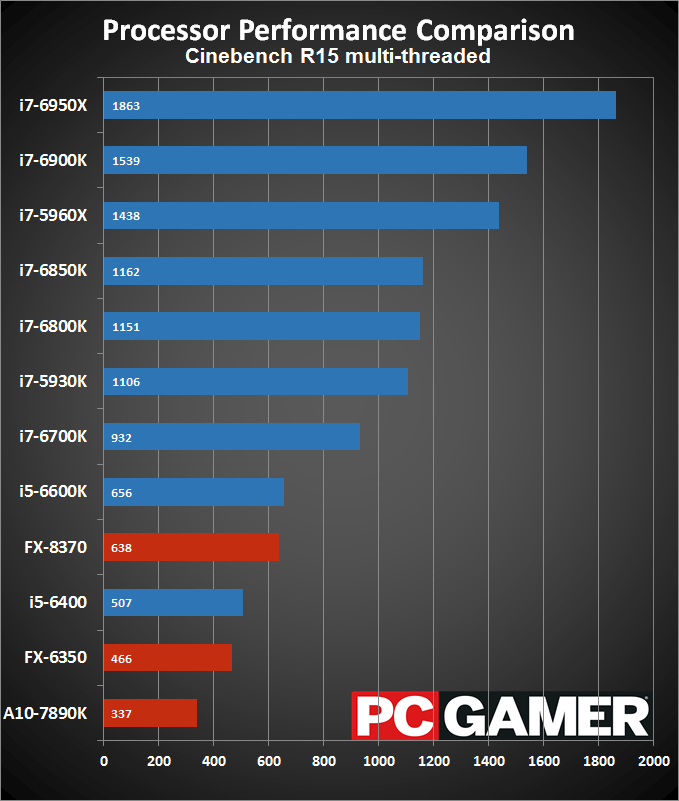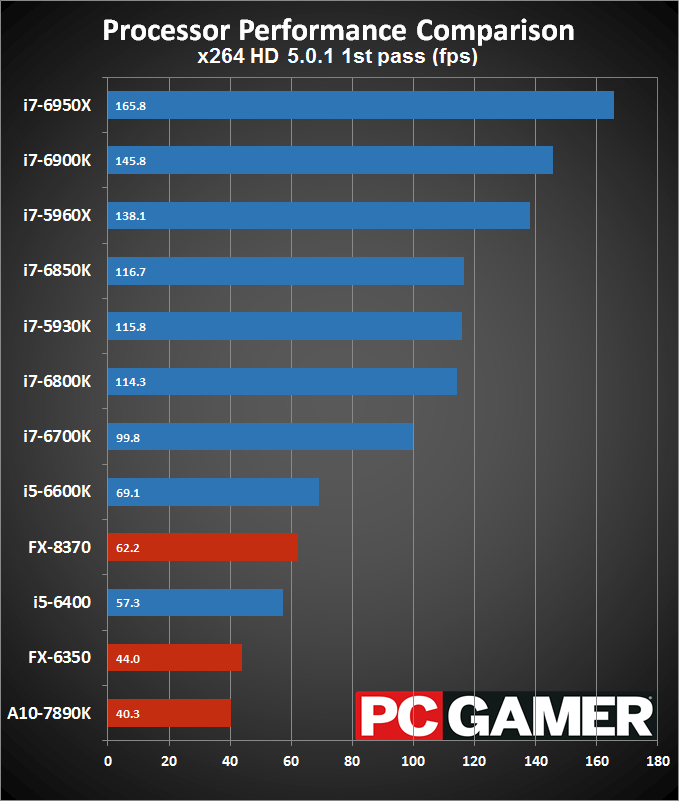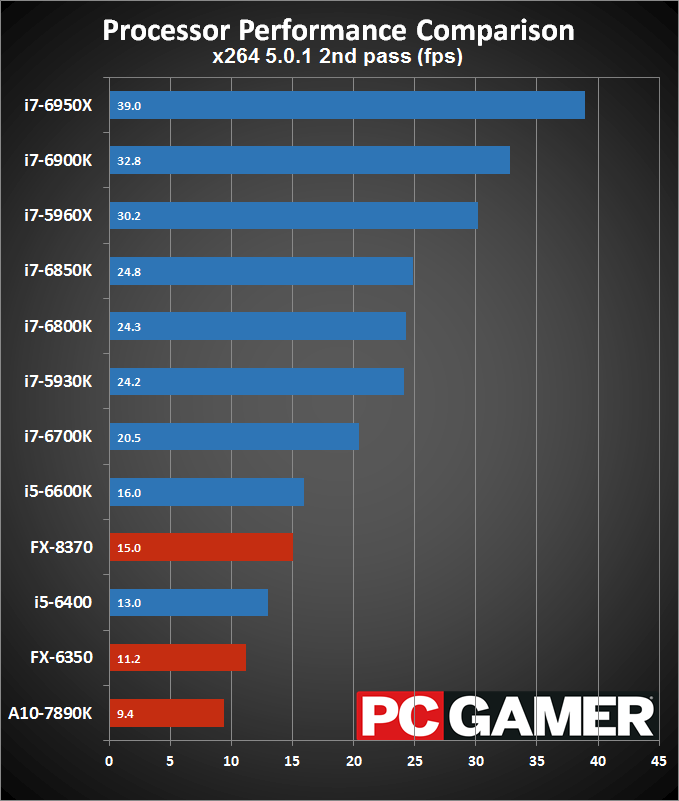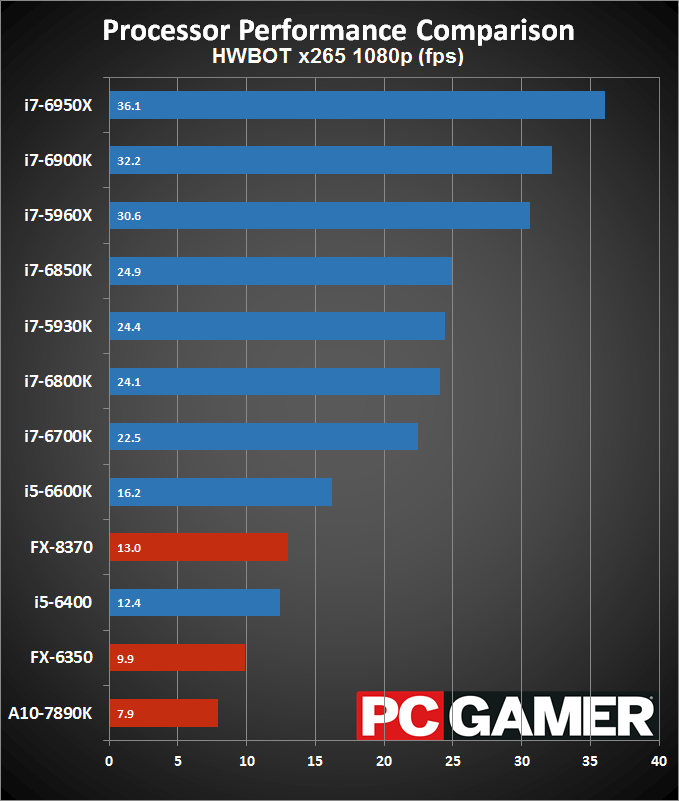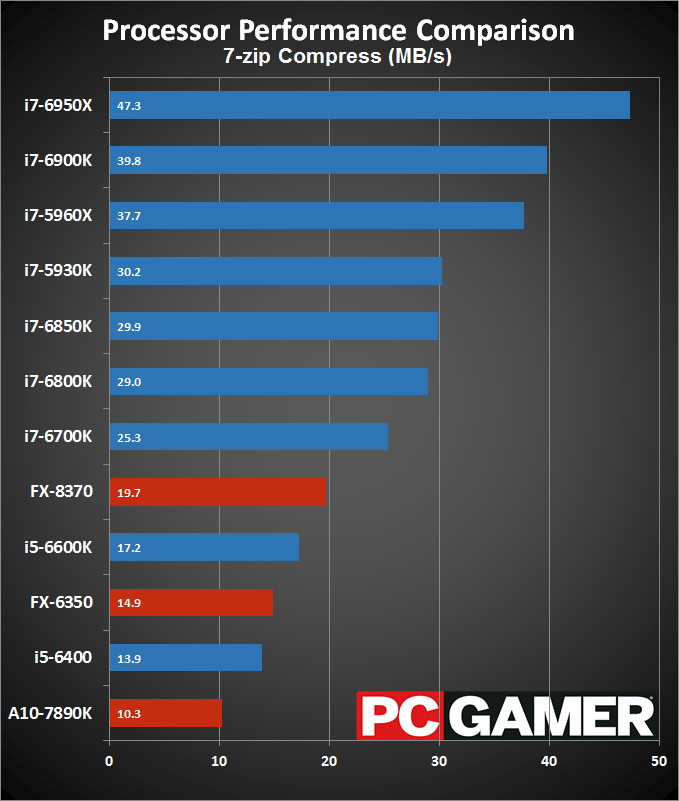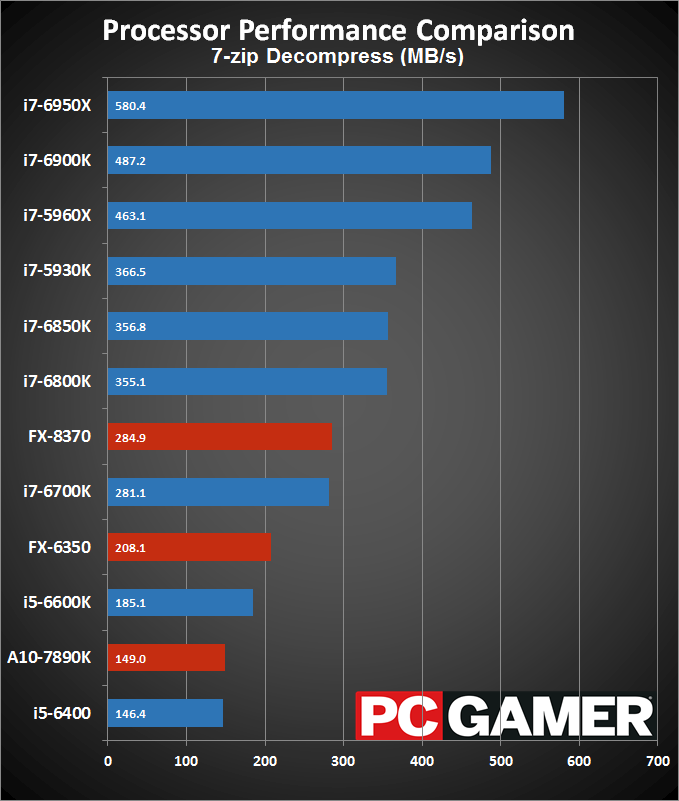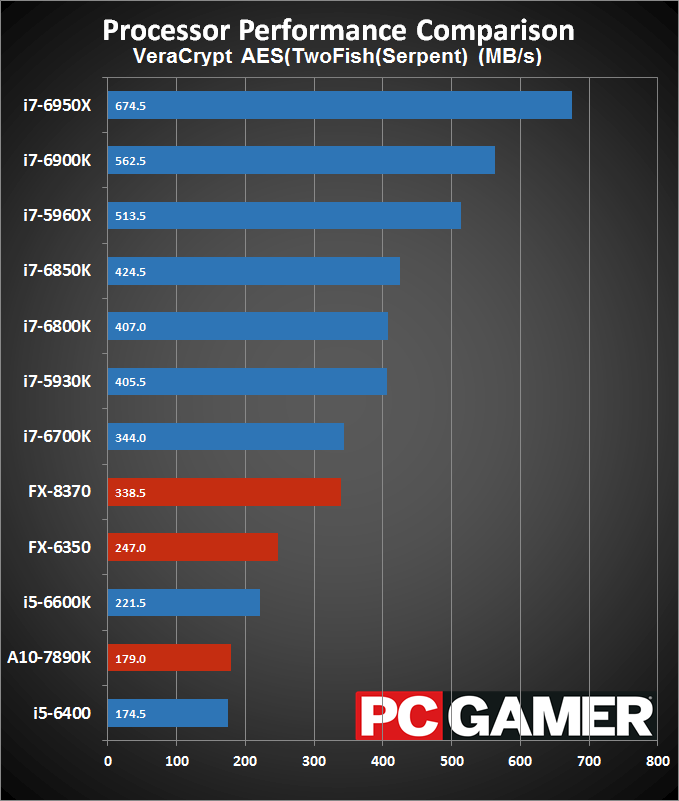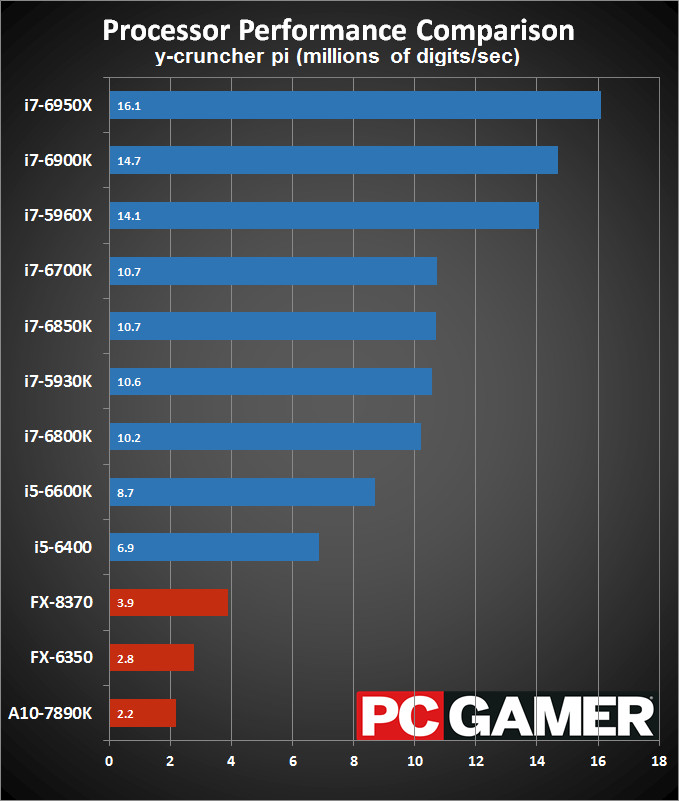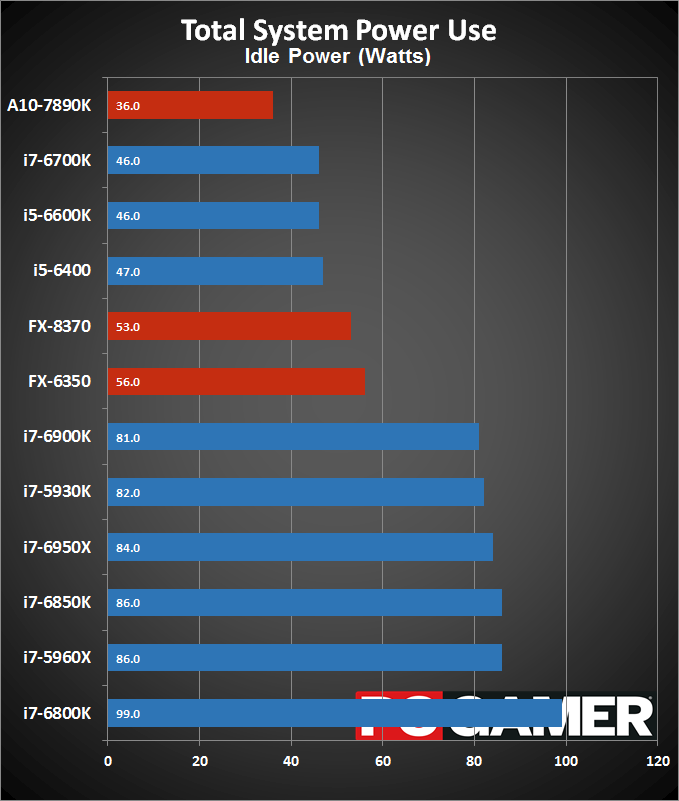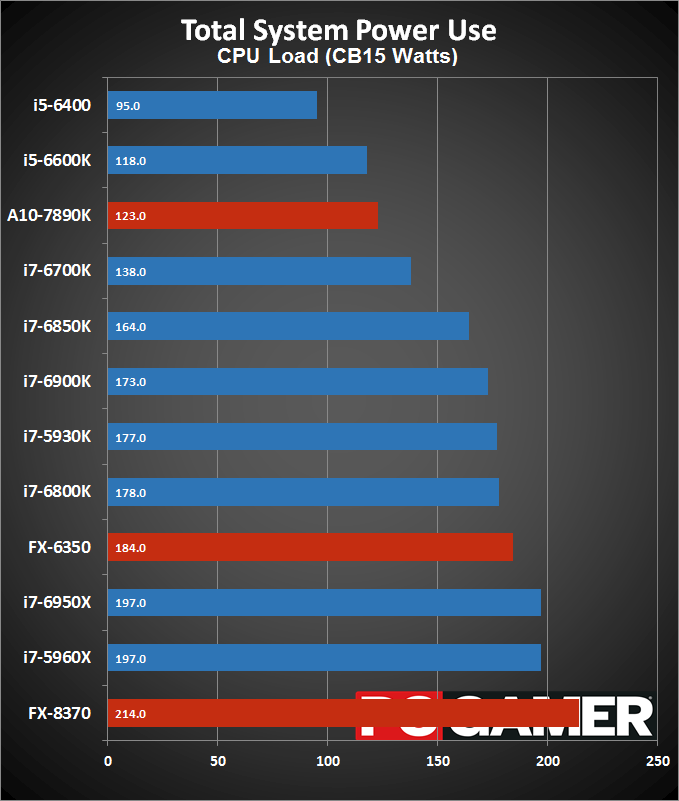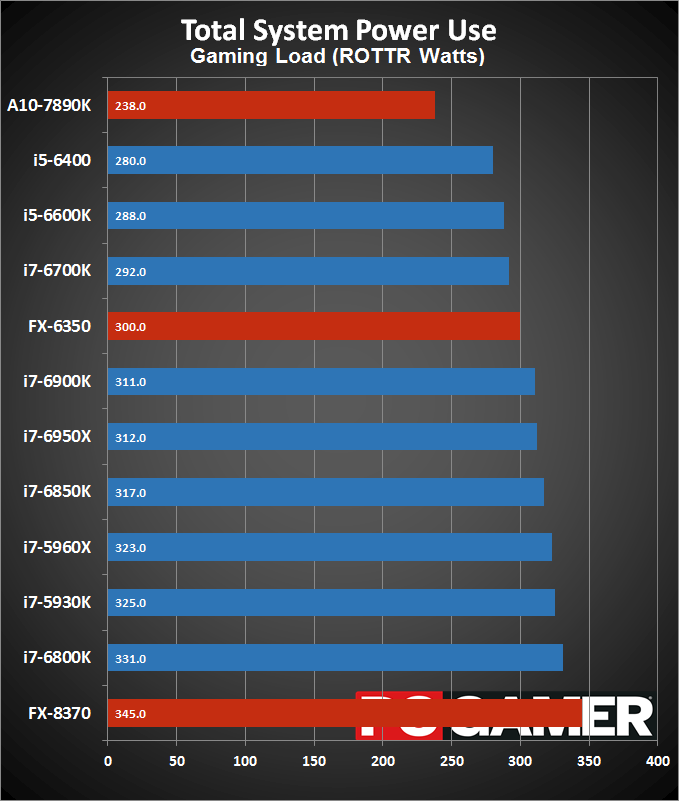The Broadwell-E Review
Four new CPUs for enthusiasts, but not so much for gaming.
What about non-gaming performance?
So far, Broadwell-E is proving to be pretty much a non-event for gaming. But while we're mostly a gaming site, we're also the people behind Maximum PC, and we do lots of stuff beyond just gaming. If you're trying to encode/transcode videos or do any other form of video editing, a fast CPU with more cores can be an amazing performance revelation. The same holds for professional applications, represented below with 3D rendering thanks to the super convenient Cinebench.
Other tests include the 7-zip benchmark for file compression/decompression, HWBOT's x265 encoding benchmark (1080p mode), VeraCrypt (an updated fork of TrueCrypt that's open source and still maintained), and y-cruncher (a super strenuous program for calculating pi digits using multiple cores—it puts a higher load on the CPU than anything else I've tested).
First is the high level overview; I've used the geometric mean of the following nine tests, so each score has equal weight. If the i7-6950X looked like a bit of a patsy in the gaming tests, this chart helps to improve the situation. Broadwell-E in general does very well, with both the 6950X and 6900K surpassing the previous generation 5960X. The 6850K likewise beats the 5930K, though just barely, with the 6800K nipping at its heels. It's also interesting to see how big of a gap there is between the 6700K and the 6600K in CPU-centric testing. Higher clock speeds help, but Hyper-Threading is clearly a big deal on heavily threaded applications. This chart also shows AMD's CPU deficit, where only the FX-8370 is able to beat the i5-6400—both are $190 parts, at least, though power requirements still favor Skylake.
Moving to the individual CPU test results, it's useful to start with single-threaded performance, and that's what Cinebench R15 provides. Clock speeds and architecture are the key ingredients to a high single-threaded score, and not surprisingly the i7-6700K easily takes the top spot. The i5-6600K isn't far off, with the lower clock speed translating straight over to the difference in score, and the various HSW-E and BDW-E parts pretty much rank according to clock speeds as well.
This particular test also highlights AMD's issue with their Bulldozer family of products: poor single-threaded performance. Architectural updates haven't helped too much, so all three processors score pretty similarly. And since the 6700K has a similar clock speed (4.2GHz), we can also see that Intel's best architecture is around 80 percent faster per core than AMD right now. AMD really needs some help from Zen, and the claimed 30 percent better IPC will definitely help close this gap.
Enabling all the cores—including virtual cores for Hyper-Threading—changes the situation in Cinebench dramatically. AMD's FX-8370 is at least able to hang out in the vicinity of the i5-6600K, thanks to eight 'real' cores versus only four cores. But while that may be nice, it's the 10-core behemoth that truly impresses. The multi-threaded test takes a few minutes on the fastest consumer processors, give or take, but the i7-6950X plows through the benchmark in about a minute—it's almost exactly twice as fast as the i7-6700K! Watching the 20 little boxes render the path tracing is highly entertaining in its own right, and I only wish I could test one of Intel's 22-core (or 24-core soon!) Broadwell Xeon chips.
The X264 HD benchmark is another commonly used test that shows how fast a system can encode a video. The catch is that it uses a high quality encoding algorithm that requires two passes, the first pass being far less strenuous than the second pass. Scaling with core counts is still good, however, and the i7-6950X beats the i7-6700K by 60 percent. If you're doing a lot of video editing and encoding for your job, having the additional cores of Intel's most expensive processors could easily pay off with improved productivity.
Keep up to date with the most important stories and the best deals, as picked by the PC Gamer team.
As mentioned above, the second pass of x264 HD is more strenuous and takes significantly longer than the first pass. It also scales better with more cores, and the i7-6950X beats the i7-6700K by 90 percent here. I haven't really mentioned this so far, but notice also that the i7-6800K and i7-6850K are nearly tied in all of the tests. Unless you're running enough add-in cards where you would need the additional PCIe lanes, the 6800K is a less expensive entry into Intel's 6-core market (though the i7-5820K is cheaper still and would likely be pretty close in performance).
The H.265 algorithm, aka HEVC, can produce similar quality video content with much lower bitrates compared to H.264. The problem is that it's far more demanding when it comes to encoding and decoding—you basically need a GPU with HEVC decode acceleration if you want to watch 4K HEVC content. I'm only using the HWBOT 1080p test, since the 4K test basically shows similar scaling but takes much longer to run. Performance mostly shadows that of the x264 second pass, but Intel does better overall compared to AMD here.
There are two aspects for file compression utilities like 7-zip: creating archives and extracting the content from archives. The compression portion can end up doing a ton of searching through memory, making it one of the few tests where RAM latency and bandwidth has more than a one percent effect on performance. Decompressing meanwhile is far easier—about ten times faster than compressing, give or take.
The additional cores again provide significant performance improvements, and the additional memory channels help as well, with the result being the i7-6950X beating the i7-6700K by 87 percent. AMD does reasonably well here, with the FX-8370 passing the i5-6600K.
AMD does even better at decompression in 7-zip, with this being the only case in my test suite where the FX-8370 can surpass the i7-6700K, and then only by about one percent. The extra cores on Intel also help, though, and the 6950X is more than twice as fast as the 6700K.
For VeraCrypt, we run the built-in benchmark with a 1GB data set and use the AES(TwoFish(Serpent())) result, as if you're trying to be as secure as possible, that's arguably the best bet for keeping the NSA out of your files. AES instruction support is enabled, and the results are the average of the encryption and decryption numbers. Core counts help tremendously here, and the FX-8370 again comes close to the i7-6700K, this time with Intel holding a scant one percent lead. The 6950X meanwhile ends up being nearly twice as fast as the 6700K.
Last but not least, we have a scientific application. Do you like calculating the digits of pi? Well, move over SuperPi—and all other open source contenders that are readily available—because y-cruncher is the fastest pi calculator around. It can use all of your processor cores, and it can also calculate the digits of other constants besides pi, so if you're interested in Euler's number, have at it. I use the all-in-RAM benchmark mode to compute one billion digits of pi. To put that in perspective, the old SuperPi program takes over six minutes to calculate 32 million digits, while even the slowest of the processors tested here takes less than eight minutes to calculate over 30 times as many digits. Pretty cool if you ask me! AES-NI (AVX) instructions are also supported, and the result is a very high power draw on all systems—and a tendency to crash quickly when overclocks aren't fully stable.
As far as performance goes, even though y-cruncher can use multiple cores, Amdahl's Law is in full effect here, and scaling beyond a certain number of cores shows rapidly diminishing returns. The 6950X is 'only' about 50 percent faster than the 6700K, for example. AMD also does quite poorly here, as each Steamroller/Piledriver module shares a single FP/AVX unit, and y-cruncher appears to be optimized for Intel architectures. The net result is that AMD's 'best' FX processor (not counting the FX-9370/9590 220W parts) is less than half the performance of an i5-6600K.
Power to the people
So far, I've talked about performance, but power use is also a factor. For power use, I used three different workloads. First is idle power at the Windows desktop, after a few minutes of inactivity but with the screen still active. Next is a fully loaded CPU benchmark using Cinebench R15, run multiple times until power stabilizes (as power draw tends to increase as components heat up). Finally, the last benchmark uses Rise of the Tomb Raider, again after things have settled down for a while—though note that the lower performance of certain processors means the GPU isn't working as hard in some cases.
First things first, idle power is definitely a strong point for AMD's FM2+ platform, though Skylake isn't that far off. The AM3+ platform ends up in third place, while the X99 platform wins out for requiring the most power—lower being better. To reiterate what I've been saying this whole time, you don't go buying a Broadwell-E system if you're planning to have it sit idle most of the time, as you're basically wasting power. There's variance among the X99 parts, but the most interesting thing is how poorly the i7-6800K sample fares compared to everything else. Binning of the Broadwell-E parts is definitely happening, and the parts that end up as 6-core models with some of the PCIe lanes disabled may not be all that great when it comes to power use and overclocking.
Once you put a full load on the CPU, things start to get a bit more interesting. Intel's Skylake parts take the top spots, with the slower i5-6400 at the top followed by the 6600K; AMD sneaks into third with the A10-7890K, and then the 6700K takes fourth place. Since the higher power chips are also faster, though, this chart needs to be considered in light of the performance offered. All the X99 chips end up falling in about a 30W range, with the i7-6850K coming in at the top and the i7-6950X and i7-5960X tied at 197W. The 6-core FX-6350 sits below the fastest Intel chips, but then the FX-8370 ends up consuming the most power. This is why AMD's FX-series has a rather poor reputation when it comes to power requirements, though these are also 32nm parts whereas Intel's chips are either 14nm or at worst 22nm.
For gaming workloads, despite offering worse performance, AMD's FX-8370 chip ends up as the highest power use. That suggests that the GPU, even though it may not be fully utilized, is still basically hitting its 180W TDP. Also note that the i7-6800K again does pretty poorly here, showing how the silicon lottery and binning are things to remember when buying a new CPU.
Considering the amount of gaming performance we're looking at, the fact that all systems stayed under 350W is worth pointing out. A good 450W power supply with an 8-pin PEG connector should be more than sufficient for a single GTX 1080, as even with a 90 percent efficiency PSU the power output is mostly under 300W. The i7-6700K for example is only using around 260W from the PSU. I still generally recommend looking to the 600W and higher range to give you some additional headroom, and for quality reasons, but a trusted brand shouldn't be a problem with lower power ratings.
Jarred's love of computers dates back to the dark ages when his dad brought home a DOS 2.3 PC and he left his C-64 behind. He eventually built his first custom PC in 1990 with a 286 12MHz, only to discover it was already woefully outdated when Wing Commander was released a few months later. He holds a BS in Computer Science from Brigham Young University and has been working as a tech journalist since 2004, writing for AnandTech, Maximum PC, and PC Gamer. From the first S3 Virge '3D decelerators' to today's GPUs, Jarred keeps up with all the latest graphics trends and is the one to ask about game performance.
